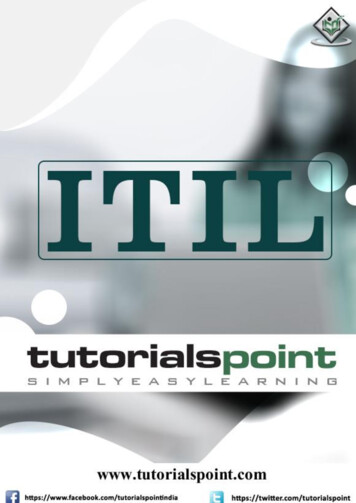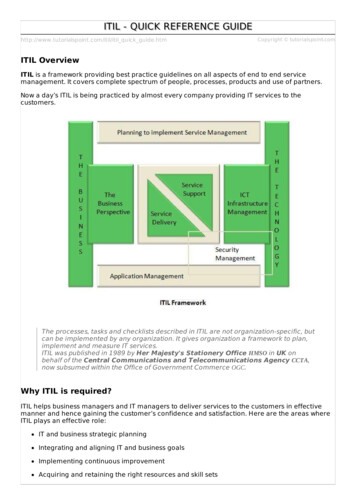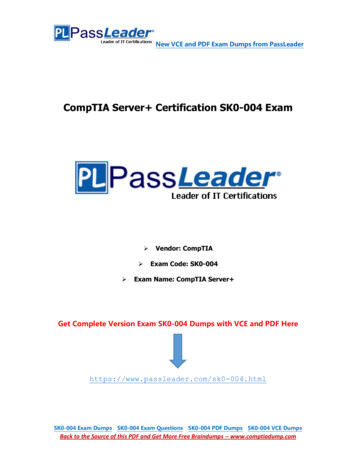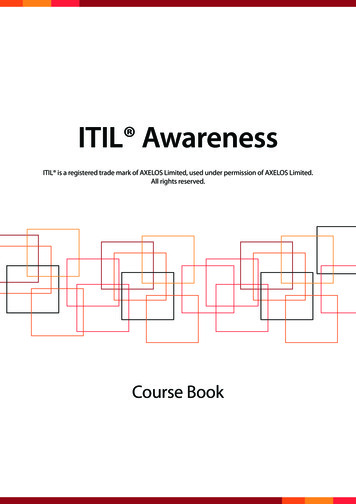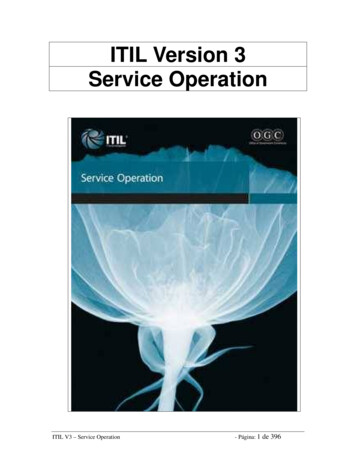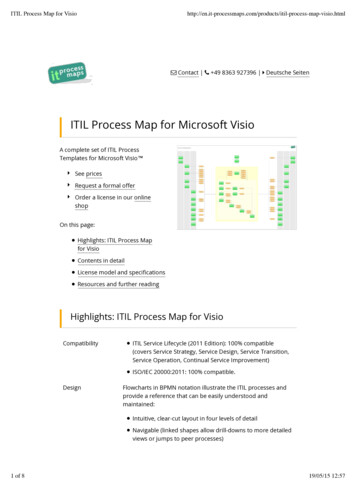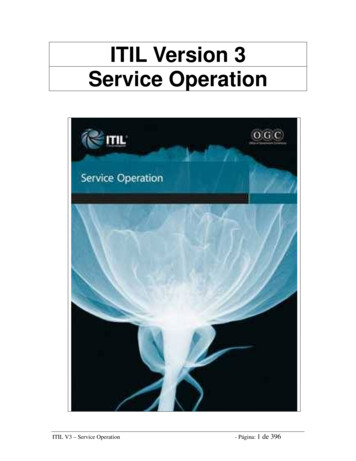
Transcription
ITIL Version 3Service OperationITIL V3 – Service Operation- Página: 1 de 396
The ITIL Core consists of five publications. Each providesthe guidance necessary for an integrated approach, asrequired by the ISO/IEC 20000 standard specification: Service StrategyService DesignService TransitionService OperationContinual Service Improvement.ITIL V3 – Service Operation- Página: 2 de 396
I N D I C EForeword.12OGC’s foreword . 12Chief Architect’s foreword . 13Preface .14Contact information . 14Acknowledgements.15Chief Architect and authors. 15ITIL authoring team . 15Mentors . 15Further contributions . 15The ITIL Advisory Group . 16Reviewers . 161 Introduction .171.1 Overview . 181.2 Context. 191.2.1 Service Management. 191.2.2 Good practice in the public domain . 191.2.3 ITIL and good practice in Service Management. 211.2.3.1 Service Strategy.221.2.3.2 Service Design.231.2.3.3 Service Transition .231.2.3.4 Service Operation .241.2.3.5 Continual Service Improvement .241.3 Purpose. 261.4 Usage. 261.5 Chapter overview . 272 Service Management as a practice.282.1 What is Service Management? . 282.2 What are services? . 302.2.1 The value proposition . 302.3 Functions and processes across the lifecycle. 312.3.1 Functions . 312.3.2 Processes. 312.3.3 Specialization and coordination across the lifecycle . 322.4 Service Operation fundamentals. 332.4.1 Purpose/goal/objective . 332.4.2 Scope. 332.4.3 Value to business . 342.4.4 Optimizing Service Operation performance . 352.4.5 Processes within Service Operation. 352.4.5.1 Event Management .352.4.5.2 Incident and Problem Management .352.4.5.3 Request Fulfilment .362.4.5.4 Access Management .362.4.6 Functions within Service Operation. 362.4.6.1 Service Desk.362.4.6.2 Technical Management.362.4.6.3 IT Operations Management .372.4.6.4 Application Management.372.4.6.5 Interfaces to other Service Management Lifecycle stages .37ITIL V3 – Service Operation- Página: 3 de 396
3 Service Operation principles .393.1 Functions, groups, teams, departments and divisions . 403.2 Achieving balance in Service Operation . 423.2.1 Internal IT view versus external business view . 423.2.2 Stability versus responsiveness . 453.2.3 Quality of service versus cost of service . 483.2.4 Reactive versus proactive . 513.3 Providing service. 563.4 Operation staff involvement in Service Design and Service Transition. 573.5 Operational Health . 583.6 Communication . 603.6.1 Meetings . 613.6.1.1 The Operations meeting.623.6.1.2 Department, group or team meetings .633.6.1.3 Customer meetings .633.7 Documentation . 644 Service Operation processes .654.1 Event Management . 674.1.1 Purpose/goal/objective . 674.1.2 Scope. 674.1.3 Value to business . 684.1.4 Policies/principles/basic concepts . 694.1.5 Process activities, methods and techniques . 704.1.5.1 Event occurs .714.1.5.2 Event notification.714.1.5.3 Event detection .724.1.5.4 Event filtering .724.1.5.5 Significance of events .724.1.5.6 Event correlation .744.1.5.7 Trigger.744.1.5.8 Response selection.754.1.5.9 Review actions.784.1.5.10 Close event .784.1.6 Triggers, input and output/inter-process interfaces. 794.1.7 Information Management. 804.1.8 Metrics . 804.1.9 Challenges, Critical Success Factors and risks . 814.1.9.1 Challenges .814.1.9.2 Critical Success Factors.814.1.9.3 Risks .824.1.10 Designing for Event Management . 824.1.10.1 Instrumentation .834.1.10.2 Error messaging.834.1.10.3 Event Detection and Alert Mechanisms .844.1.10.4 Identification of thresholds .844.2 Incident Management. 864.2.1 Purpose/goal/objective . 864.2.2 Scope. 864.2.3 Value to business . 864.2.4 Policies/principles/basic concepts . 874.2.4.1 Timescales.874.2.4.2 Incident Models.874.2.4.3 Major incidents.884.2.5 Process activities, methods and techniques . 894.2.5.1 Incident identification .904.2.5.2 Incident logging.914.2.5.3 Incident categorization .92ITIL V3 – Service Operation- Página: 4 de 396
4.2.5.4 Incident prioritization .944.2.5.5 Initial diagnosis .964.2.5.6 Incident escalation .96Note regarding Incident allocation . 974.2.5.7 Investigation and Diagnosis .974.2.5.8 Resolution and Recovery .984.2.5.9 Incident Closure .99Rules for re-opening incidents. 1004.2.6 Triggers, input and output/inter-process interfaces. 1004.2.7 Information Management. 1014.2.8 Metrics . 1024.2.9 Challenges, Critical Success Factors and risks . 1034.2.9.1 Challenges .1034.2.9.2 Critical Success Factors.1034.2.9.3 Risks .1034.3 Request Fulfilment . 1054.3.1 Purpose/goal/objective . 1054.3.2 Scope. 1054.3.3 Value to business . 1064.3.4 Policies/principles/basic concepts . 1064.3.4.1 Request Models .1064.3.5 Process activities, methods and techniques . 1064.3.5.1 Menu selection.1064.3.5.2 Financial approval.1074.3.5.3 Other approval .1074.3.5.4 Fulfilment .1074.3.5.5 Closure.1084.3.6 Triggers, input and output/inter-process interfaces. 1084.3.7 Information Management. 1084.3.8 Metrics . 1094.3.9 Challenges, Critical Success Factors and risks . 1094.3.9.1 Challenges .1094.3.9.2 Critical Success Factors.1094.3.9.3 Risks .1104.4 Problem Management. 1114.4.1 Purpose/goal/objective . 1114.4.2 Scope. 1114.4.3 Value to business . 1114.4.4 Policies/principles/basic concepts . 1124.4.4.1 Problem Models .1124.4.5 Process activities, methods and techniques . 1124.4.5.1 Problem detection .1134.4.5.2 Problem logging .1144.4.5.3 Problem Categorization.1154.4.5.4 Problem Prioritization .1154.4.5.5 Problem Investigation and Diagnosis .1154.4.5.6 Workarounds.1194.4.5.7 Raising a Known Error Record.1194.4.5.8 Problem resolution .1194.4.5.9 Problem Closure .1204.4.5.10 Major Problem Review .1204.4.5.11 Errors detected in the development environment.1204.4.6 Triggers, input and output/inter-process interfaces. 1214.4.7 Information Management. 1224.4.7.1 CMS .1224.4.7.2 Known Error Database.1234.4.8 Metrics . 1244.4.9 Challenges, Critical Success Factors and risks . 1254.5 Access Management. 126ITIL V3 – Service Operation- Página: 5 de 396
4.5.1 Purpose/goal/objective . 1264.5.2 Scope. 1264.5.3 Value to business . 1264.5.4 Policies/principles/basic concepts . 1274.5.5 Process activities, methods and techniques . 1274.5.5.1 Requesting access.1274.5.5.2 Verification .1274.5.5.3 Providing rights .1284.5.5.4 Monitoring identity status .1294.5.5.5 Logging and tracking access.1304.5.5.6 Removing or restricting rights .1304.5.6 Triggers, input and output/inter-process interfaces. 1314.5.7 Information Management. 1324.5.7.1 Identity .1324.5.7.2 Users, groups, roles and service groups.1334.5.8 Metrics . 1344.5.9 Challenges, Critical Success Factors and risks . 1344.6 Operational activities of processes covered in other lifecycle phases . 1364.6.1 Change Management . 1364.6.2 Configuration Management . 1364.6.3 Release and Deployment Management . 1374.6.4 Capacity Management. 1374.6.4.1 Capacity and Performance Monitoring .1374.6.4.2 Handling capacity- or performance-related incidents .1394.6.4.3 Capacity and performance trends .1394.6.4.4 Storage of Capacity Management data.1404.6.4.5 Demand Management .1404.6.4.6 Workload Management .1404.6.4.7 Modelling and applications sizing.1414.6.4.8 Capacity Planning .1414.6.5 Availability Management. 1424.6.6 Knowledge Management. 1444.6.7 Financial Management for IT services . 1444.6.8 IT Service Continuity Management . 1445 Common Service Operation activities .1465.1 Monitoring and control. 1495.1.1 Definitions. 1495.1.2 Monitor Control Loops . 1505.1.2.1 Complex Monitor Control Loop .1525.1.2.2 The ITSM Monitor Control Loop.1545.1.2.3 Defining what needs to be monitored.1565.1.2.4 Internal and External Monitoring and Control.1575.1.2.5 Defining objectives for Monitoring and Control.1575.1.2.6 Types of monitoring .1595.1.2.7 Monitoring in Test Environments.1615.1.2.8 Reporting and action .1625.1.2.9 Service Operation audits.1625.1.2.10 Measurement, metrics and KPIs .163Measurement . 163Metrics . 164Key Performance Indicators . 1645.1.2.11 Interfaces to other Service Lifecycle practices .164Operational Monitoring and Continual Service Improvement. 1645.2 IT Operations . 1665.2.1 Console Management/Operations Bridge . 1665.2.2 Job Scheduling . 1675.2.3 Backup and Restore . 1685.2.3.1 Backup .169ITIL V3 – Service Operation- Página: 6 de 396
5.2.3.2 Restore .1705.2.4 Print and Output . 1715.3 Mainframe Management . 1725.4 Server Management and Support . 1735.5 Network Management . 1755.6 Storage and Archive. 1775.7 Database Administration . 1795.8 Directory Services Management . 1805.9 Desktop Support . 1815.10 Middleware Management. 1825.11 Internet/Web Management. 1845.12 Facilities and Data Centre Manag
ITIL V3 – Service Operation - Página: 2 de 396 The ITIL Core consists of five publications. Each provides the guidance necessary for an integrated approach, as required by the ISO/IEC 20000 standard specification: Service Str



